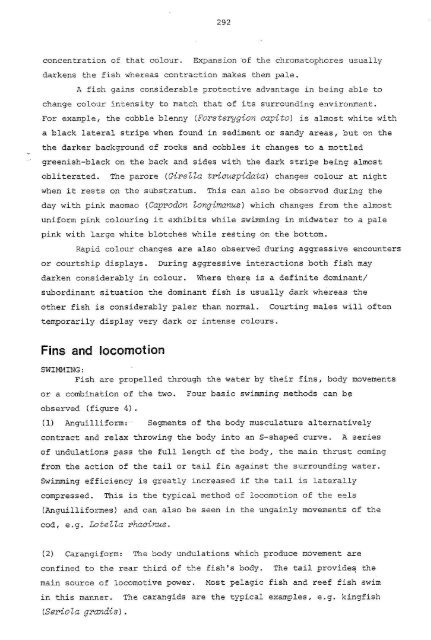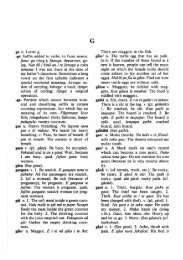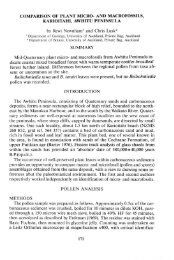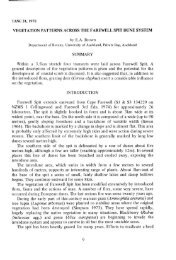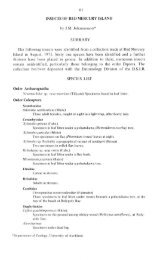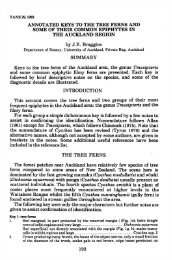aspects of fish biology form and function
aspects of fish biology form and function
aspects of fish biology form and function
Create successful ePaper yourself
Turn your PDF publications into a flip-book with our unique Google optimized e-Paper software.
292a<br />
concentration <strong>of</strong> that colour. Expansion "<strong>of</strong> the chromatophores usually<br />
darkens the <strong>fish</strong> whereas contraction makes them pale.<br />
A <strong>fish</strong> gains considerable protective advantage in being able to<br />
change colour intensity to match that <strong>of</strong> its surrounding environment.<br />
For example, the cobble blenny (Forsterygion capito) is almost white with<br />
a black lateral stripe when found in sediment or s<strong>and</strong>y areas, but on the<br />
the darker background <strong>of</strong> rocks <strong>and</strong> cobbles it changes to a mottled<br />
greenish-black on the back <strong>and</strong> sides with the dark stripe being almost<br />
obliterated. The parore {Givella tricuspidata) changes colour at night<br />
when it rests on the substratum. This can also be observed during the<br />
day with pink rnaomao (Caprodon longimanus) which changes from the almost<br />
uni<strong>form</strong> pink colouring it exhibits while swimming in midwater to a pale<br />
pink with large white blotches while resting on the bottom.<br />
Rapid colour changes are also observed during aggressive encounters<br />
or courtship displays. During aggressive interactions both <strong>fish</strong> may<br />
darken considerably in colour. Where there is a definite dominant/<br />
subordinant situation the dominant <strong>fish</strong> is usually dark whereas the<br />
other <strong>fish</strong> is considerably paler than normal. Courting males will <strong>of</strong>ten<br />
temporarily display very dark or intense colours.<br />
Fins <strong>and</strong> locomotion<br />
Fish are propelled through the water by their fins, body movements<br />
or a combination <strong>of</strong> the two. Four basic swimming methods can be<br />
observed (figure 4) .<br />
(1) Anguilli<strong>form</strong>: Segments <strong>of</strong> the body musculature alternatively<br />
contract <strong>and</strong> relax throwing the body into an S-shaped curve. A series<br />
<strong>of</strong> undulations pass the full length <strong>of</strong> the body, the main thrust coming<br />
from the action <strong>of</strong> the tail or tail fin against the surrounding water.<br />
Swimming efficiency is greatly increased if the tail is laterally<br />
compressed. This is the typical method <strong>of</strong> locomotion <strong>of</strong> the eels<br />
(Anguilli<strong>form</strong>es) <strong>and</strong> can also be seen in the ungainly movements <strong>of</strong> the<br />
cod, e.g. Lotella rhacinus.<br />
(2) Carangi<strong>form</strong>: The body undulations which produce movement are<br />
confined to the rear third <strong>of</strong> the <strong>fish</strong>'s body. The tail provides the<br />
main source <strong>of</strong> locomotive power. Most pelagic <strong>fish</strong> <strong>and</strong> reef <strong>fish</strong> swim<br />
in this manner. The carangids are the typical examples, e.g. king<strong>fish</strong><br />
(Seriola gr<strong>and</strong>is).


